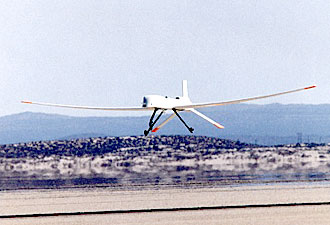Altus
General Atomics' Altus vehicle was used to verify technologies that will lead to a long-duration (12 to 72 hours), high altitude vehicle capable of carrying a 330 pound science payload. The efforts include work on engine integration, flight operations techniques and procedures, lightweight structures, science payload integration and science mission demonstration.

In October 1996, Altus set an endurance record for RPV's carrying science payloads. The vehicle spent more than 24 hours at the required altitude during a Department of Energy atmospheric-radiation measurement experiment. Altus was modified to a dual turbocharger configuration and returned to flight test in the Spring of 1998. The dual turbo-charged aircraft accomplished flights of 3 hours above 55,000 feet altitude and 8 hours at 50,000 feet altitude in March, 1999.
Altus Vehicle Description
| Owner |
General Atomics Aeronautical System Inc. and NASA |
| Manufacturer |
General Atomics Aeronautical System Inc. |
| Fuselage Length |
23.6 ft. |
| Wingspan |
55.3 ft. |
| Wing Area |
132 ft. |
| Aspect Ratio |
23.2 |
| Maximum Take-off Weight |
2,150 lbs. |
| Payload |
330 lbs. |
| Maximum Altitude |
68,000 ft. |
| Mission Duration |
30 hrs. |
| Structure |
Composite Construction |
| Engine |
Rotax 912-2T |
| Engine Horsepower |
100 @ 52,000 ft. |
| Propeller |
8.2 ft. in Diameter |

Project Milestones
| September 5, 1996 |
Altus reaches a personal best by attaining 37,000 feet for more than 2 hours. |
| October 1996 |
Altus sets endurance record for RPV's carrying science payloads on a 26-hour flight. |
| Summer 1997 |
Altus reaches 43,500 feet during development flights. |
| Spring 1998 |
Altus returns to flight test |
| March 1999 |
Altus flies for three hours above 55,000 feet and eight hours at 50,000 feet altitude. |
| July 23, 1999 |
Altus flies to 55,000 feet over 4 hours. |
Altus Links

